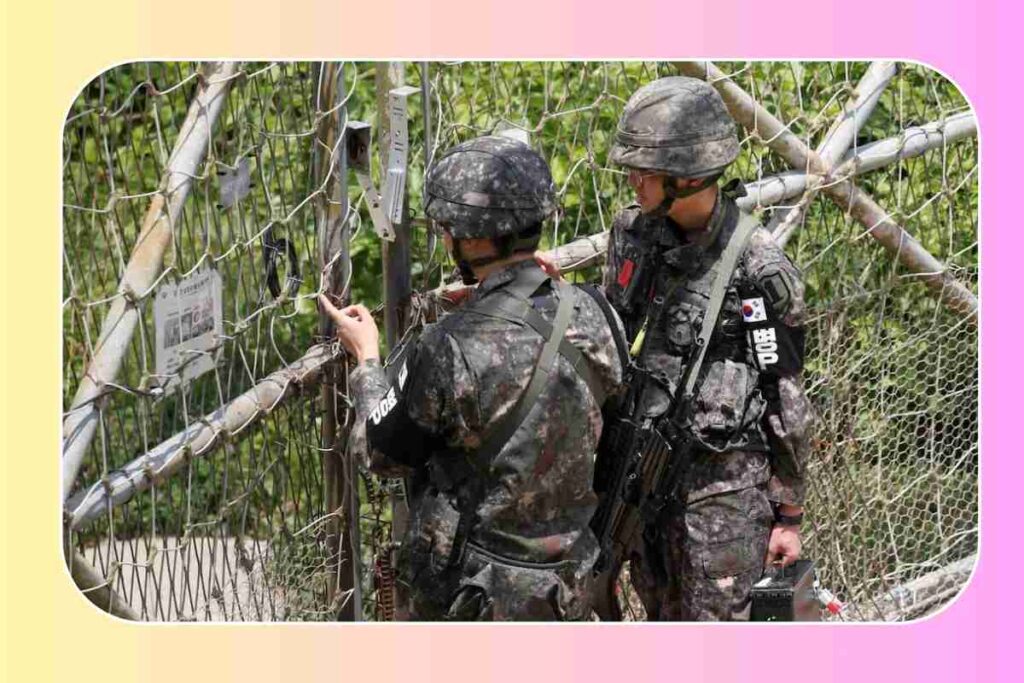South Korea Fires Warning Shots After North Korean Troops Briefly Cross Border

Tensions along the Demilitarized Zone (DMZ) between South and North Korea have been reignited following an incident involving North Korean soldiers crossing the heavily fortified border. This event sheds light on the ongoing complexities of one of the world’s most militarized zones and the fragile relations between the two Koreas.
This blog aims to analyze the unfolding incident, its potential causes, and its broader implications in the context of the growing tensions on the Korean Peninsula.
What Happened on April 8, 2025?
South Korea’s military reported that approximately 10 North Korean soldiers, some armed and wearing bulletproof vests, crossed the demarcation line in the eastern section of the Demilitarized Zone (DMZ) at around 5 PM local time.
The South Korean defense forces responded promptly by issuing a warning broadcast and firing warning shots, an established procedure for addressing such breaches. The North Korean troops retreated shortly after without any escalation or return fire, according to South Korea’s Joint Chiefs of Staff (JCS).
Reports from South Korean media suggest that the incursion may have been unintended, possibly occurring during a reconnaissance mission or preparatory works for frontline defense by North Korea. However, with limited clarity on the intent, the event has spared speculation about the increasing militarization along the DMZ.
Why the DMZ is a Flashpoint
The DMZ, established in the aftermath of the Korean War (1950-1953), is one of the most dangerous borders in the world. Spanning 248 km (155 miles) in length and 4 km (2.5 miles) in width, it is heavily fortified with landmines, barbed wire fences, tank traps, and combat troops on both sides.
While the zone serves as a physical barrier between the two nations, it is also a continuing reminder of the conflict that ended without a peace treaty, leaving the countries technically still at war. The DMZ, with its occasional skirmishes and border intrusions like the one witnessed recently, remains a symbol of unresolved tensions.
What Might Have Sparked the Incident?
Several factors might have played a role in this new border breach.
Routine or Accidental Intrusion
South Korean media has speculated that the North Korean troops could have crossed the border unintentionally during patrols or reconnaissance activities. This has precedent; similar incidents occurred last year when unclear or poorly marked signage in certain wooded areas of the DMZ saw North Korean soldiers unintentionally straying across the border.
Escalation of Frontline Works
North Korea announced in October 2024 its intention to reinforce border defenses amidst what it described as “confrontational hysteria” by South Korea and the United States. Efforts such as reinforcing barbed wire fences and planting landmines have since been observed near the North’s frontlines, adding to tensions in the region. Tuesday’s activities might have been part of such works.
Strategic Posturing
Given the increased political and military tensions on the Peninsula, deliberate, albeit small-scale, incursions cannot be ruled out. North Korea may be testing South Korea’s border defenses or attempting to make a statement amidst its broader diplomatic and military positioning against South Korea and its ally, the United States.
Broader Context of South-North Tensions
Tuesday’s incident comes amidst already heightened tensions on the Korean Peninsula.
Shifting Alliances and Policies
South Korea’s internal political challenges have added another layer of complexity. The recent impeachment and removal of President Yoon Suk Yeol from office, following controversies over authoritarian measures, leaves a leadership vacuum as the nation prepares for elections in June. Yoon’s aggressive stance on defense and closer military drills with the United States were key points of friction with the North.
Simultaneously, North Korea continues to align itself more closely with Russia, sending thousands of soldiers and weaponry in support of the war in Ukraine. This solidifies their anti-West alliance and increases tension with the U.S.-South Korea partnership.
Pyongyang’s Nuclear Ambitions
North Korea’s frequent displays of military might, including missile launches and nuclear posturing, have been constant reminders of its growing capability. It has ignored calls for denuclearization negotiations, further straining the already fractured relationship with its southern counterpart.
Border Provocations
Incidents of border incursion—whether deliberate or accidental—are not uncommon. However, they serve as a dangerous reminder of how quickly tensions can escalate near such a volatile boundary.
What Could This Incident Mean for the Region?
This recent crossing might appear minor, given there were no casualties and no return fire from North Korea. However, it underscores the fragility of peace along the DMZ and the risks of miscalculations escalating into broader conflicts.
For Seoul, Tuesday’s event highlights the importance of maintaining robust border surveillance and rapid response protocols. The possibility that such incursions may be accidental does not diminish the need for vigilance amidst the growing militarization of the border area.
For Pyongyang, such incidents—whether intentional or not—could be used to justify additional military buildup or political posturing aimed at pressuring South Korea and its allies.
Finally, for external stakeholders like the United States, this incident adds another layer of complexity in addressing regional stability and security as North Korea’s alignment with Russia further complicates diplomatic relations.
The Path Forward
While tensions remain high, Tuesday’s incident serves as a reminder of the urgent need for dialogue and proactive measures to reduce risks of escalation. Both Koreas, along with their allies and partners, must prioritize communication channels to avoid misunderstandings and maintain peace along one of the world’s most dangerous borders.
Stay Updated
The situation along the Korean Peninsula continues to evolve, with geopolitical ramifications extending well beyond the region. For the latest analysis and expert commentary on issues like these, stay informed by signing up for our newsletter.





